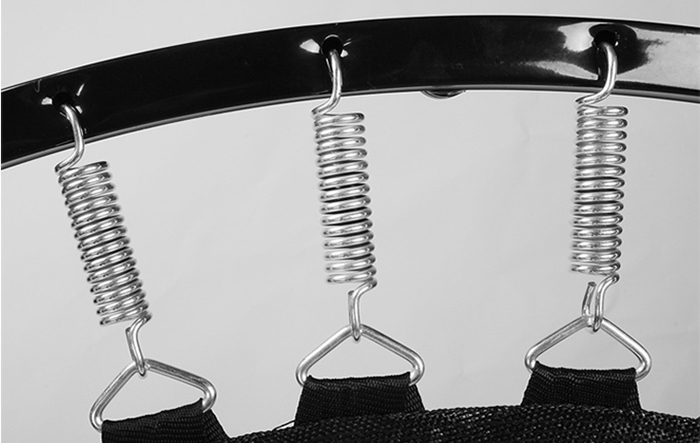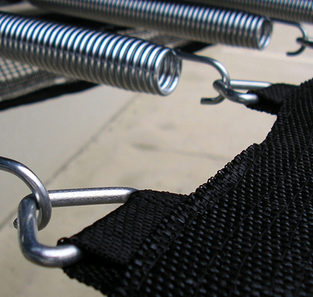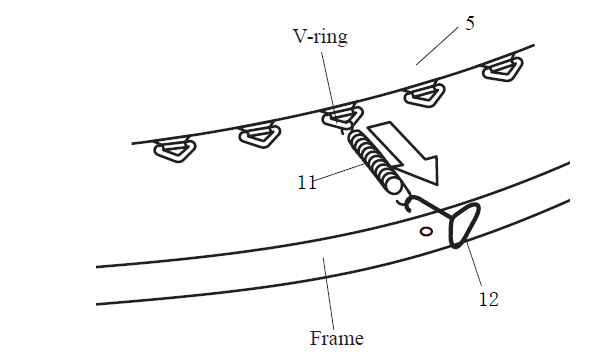The replacement for trampoline springs are crucial parts of a trampoline.
They determine the performance of a trampoline.
That is, whether one will experience a good bounce or not.
This accessory is not different from the ordinary springs we use in our daily activities except that, they have been designed specifically to be used with trampolines.
Below is an image of a single spring. The arrow indicates the length of the spring.

As you can see from the image above, these springs are small coiled pieces of metal wire.
They come in different shapes and sizes manufactured from different metals.
They are the most popular trampoline accessories that are compatible with nearly all trampoline brands.
Replacing the trampoline springs will depend on very a number of factors such as:
- When a spring has overstretch
- Springs that have deformed permanently, thus disobeying Hooke’s law
- The springs are loose
The springs connect the trampoline mat and the trampoline frame.

It is important that you follow the recommended trampoline spring installation procedures.
The figure below shows how the trampoline springs appear when installed on the trampolines.
How to check the quality of replacement springs for trampolines
To check the quality of trampoline springs, you need to understand some basic factors about the spring’s principle of operation.
Ideally, the springs we use in trampolines basically depend on Hooke’s Law.
The Hooke’s law tries to expound on the principle of elasticity.
This law states that, a force (F) applied on one end of a spring is directly proportional to the change in the length (X) brought about by the force multiplied by the constant “k”.
It goes a head to state that this only holds when the spring does not extend beyond the plastic deformation.
Graphically, this can be represented as:

This is a graphical representation of how the replacement springs for trampolines behave when subjected to a load
This is a graphical representation of how the replacement springs for trampolines behave when subjected to a load.
Having explored the technical aspect of how an ordinary spring operate, let me expound on this based on the trampoline springs.
What am I trying to illustrate?
It is simple, Hooke’s Law form the foundation from which the trampoline springs work.
That is, the force demoted by letter “F” above, is the tension force that is exerted on the springs when one steps on the mat.
When jumping up, the force is withdrawn thus, the spring retracts.
A trampoline that can retain its original shape after being subjected to the tension is said to obeying the Hooke’s Law.
This is the region represented on the graph above by the “elastic region”.
When it doesn’t retain its original shape, then the spring is said to have undergone permanent deformation.
It can fracture after this point. A trampoline spring that has undergone permanent deformation must be replaced.
This is because such trampolines won’t rebound effectively.

All the tests that determine the quality or effectiveness of springs are based on this basic fact.
Again, all springs do not have the same spring constant (k).
This will depend on:
- The types of materials, be it steel or zinc springs. This will determine the ability of the spring to expand and contract depending on the amount of the tension force it is subjected to.
- The surface area of the wire
The trampoline spring tests
Whenever you’re conducting quality test for the replacement springs for trampolines, the tests should be based on the critical aspects that determine the performance of spring.
These key factors include:
1.The coating materials;
Trampoline springs are coated to enhance their corrosion resistance performance.
The trampoline zinc coated springs are commonly used in the industry.
2.The external length of the spring;
They come in different lengths that may vary between 180, 215, 230 and 250mm.
Refer to the figure above to determine the length of your trampoline spring.
3.The diameter of wire.
It may vary between 3.2 to 3.3 mm
4.The spire diameter
5.The coil tension and conical extremities
Some of these spring tests require sophisticated testing equipment and they can only be conducted in industrial setup.
Therefore, it’s only by examining the contraction and expansion of springs that you can tell whether spring has been manufactured from quality material of not.
The quality of replacement springs for trampolines based on the following key tests:
1.The spring compression tests;
The ability of the to retain its original shape when subjected to compression forces that reduce the spring’s length.
2.The spring extension tests;
It tests whether a spring can extend and retain its original length after the force is withdrawn.
3.The spring torsion tests
In addition to these, the hooks of the springs must be tested and designed in a manner that they can hold both the trampoline spring and the mat without slipping or deforming.

NOTE: You have to examine the trampoline spring hook to ensure that it can support the weight of the trampoline users.
Summary
The replacement springs for trampolines are vital accessories that determine the performance of a trampoline.
It is important to purchase these accessories from a reputable store besides testing their expansion and contraction.
All the trampoline springs should be tested individually to ensure consistency and optimal performance.
More importantly, you should buy or import these springs from reputable manufacturers.

